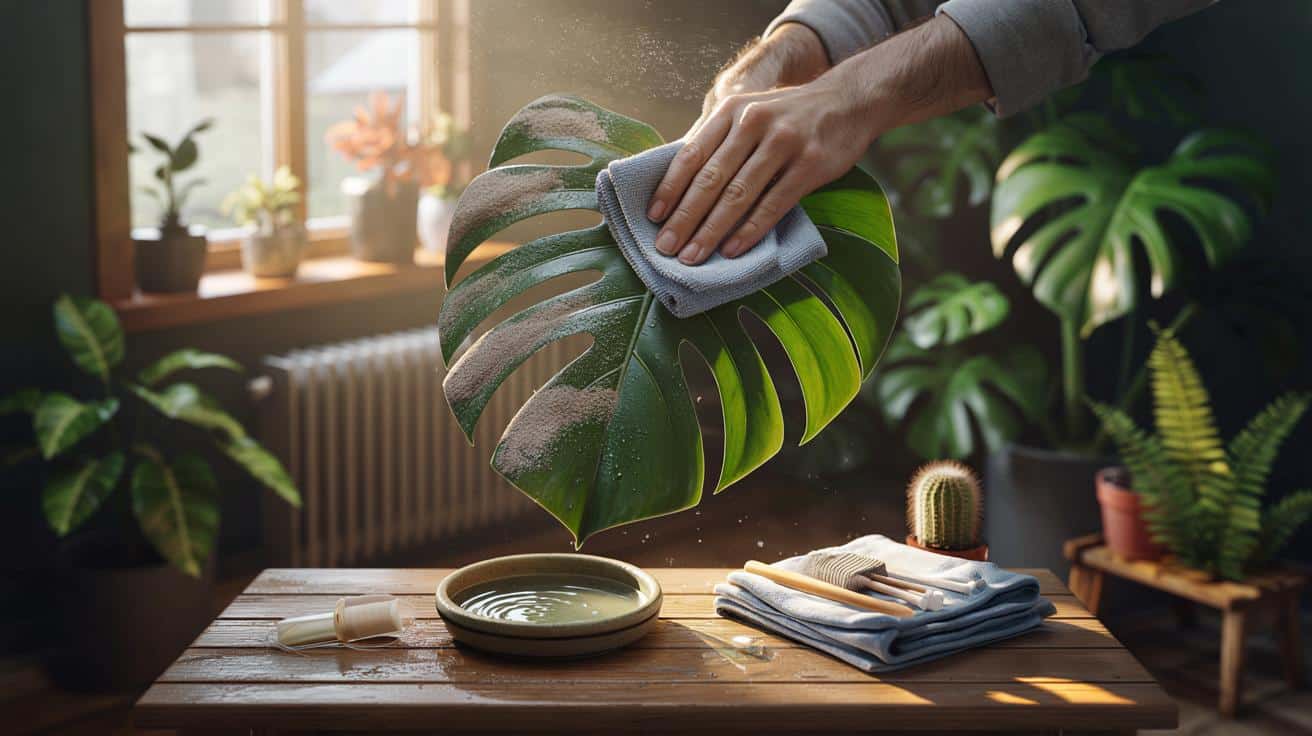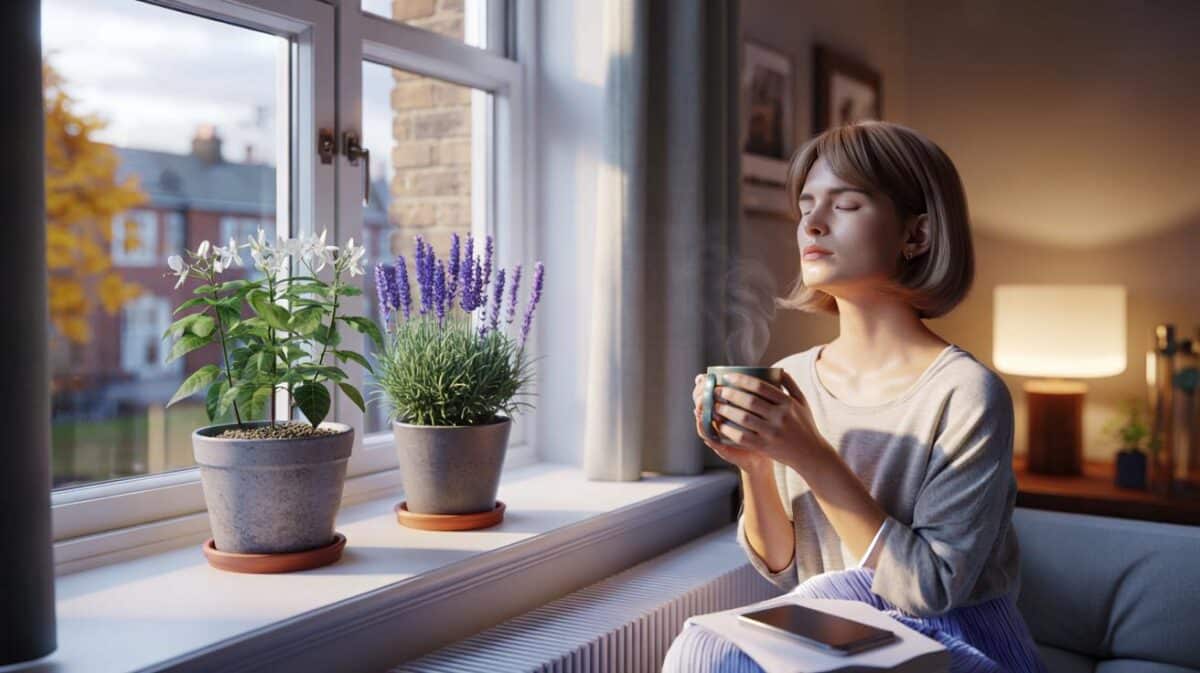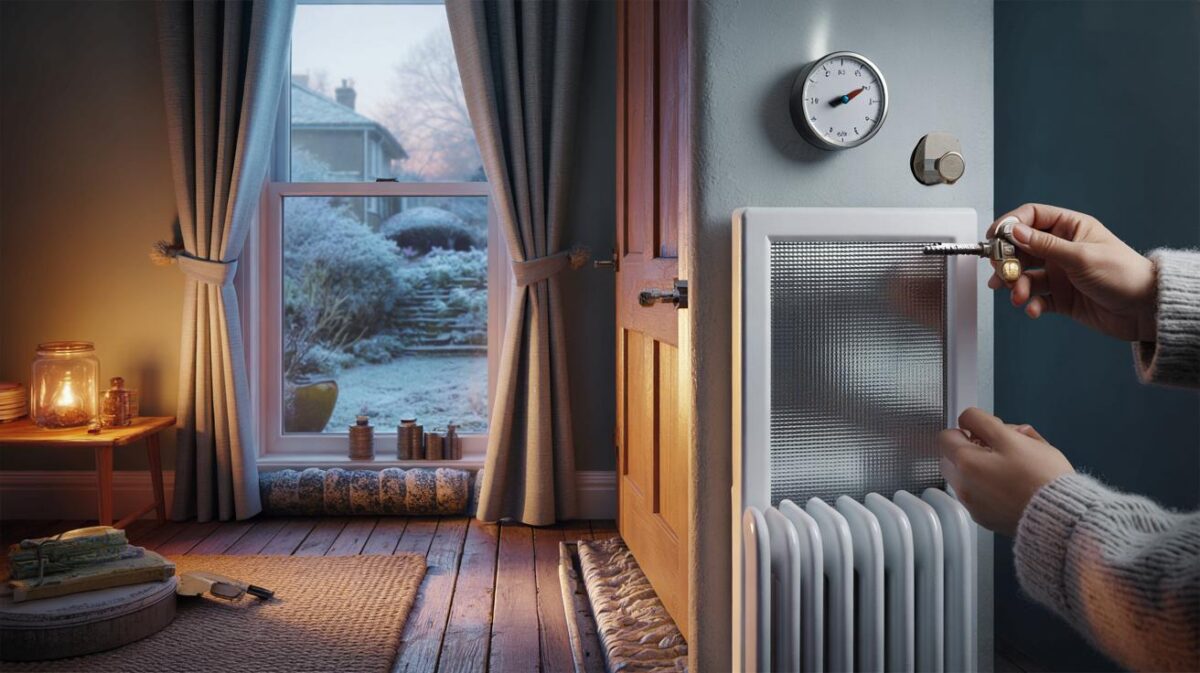As heating clicks on and light levels fall, dust builds, humidity dips and growth slows. A quick, no-product routine can reset the balance and put the shine back, while keeping your home’s air feeling fresher.
Why your leaves go dull and dusty
Once the heating season starts, indoor relative humidity often drops below 35%. That dry air lifts fine particles from carpets, curtains and clothes, and those particles settle on foliage. Even a thin film blocks incident light and forces the plant to work harder for the same energy. Research on urban dust shows it can cut leaf-level light capture by 20% or more, especially when skies are grey and windows stay closed. Less light equals less photosynthesis, slower growth and a tired look.
Dust also hides early signs of trouble. Mites thrive in warm, dry rooms and love dusty leaf undersides. Scale insects blend into grimy petioles. Wiping clears the surface and makes pests easier to spot before populations balloon.
A fingertip of dust doesn’t just look drab. It can slash winter light reaching a leaf by a fifth or more.
The two-minute habit: 1 cloth, 2 minutes, 0 chemicals
You don’t need shop-bought leaf-shine to revive a plant. A damp microfibre cloth and lukewarm water do the job cleanly and safely. Microfibre grabs particles without scratching the cuticle, and water loosens grime without leaving residue that can clog pores.
Step-by-step that actually works
- Fill a small bowl with lukewarm water (about 20–25°C). Cold shocks tissue; hot can mark it.
- Dip a clean microfibre cloth, wring it out hard. Aim for damp, not dripping.
- Support the leaf from beneath with one hand. With the other, wipe the top surface along the veins, then the underside.
- Rinse and wring the cloth after every 2–3 leaves to avoid spreading grime or pests.
- Dry splashes from the central crown of rosette plants to prevent rot.
- Repeat every 2–4 weeks from October to March; weekly for plants sitting near roads, radiators or fireplaces.
- Skip oil, milk, mayonnaise or leaf-shine sprays. They leave films that attract dust and can block stomata.
One damp cloth, one careful wipe, repeated every 2–4 weeks: more light, fewer mites, better-looking plants.
Match the method to the plant
Not all foliage likes the same treatment. Leaf size, texture and architecture dictate the safest clean-up.
Broad, delicate or spiky?
| Plant type | Best method | How often | Watch for |
|---|---|---|---|
| Monsteras, rubber plants, philodendrons | Damp microfibre wipe, both sides | Every 2–4 weeks | Support heavy leaves to avoid tearing; clean fenestrations with a cotton bud |
| Calatheas, marantas, ferns | Soft, dry paintbrush to lift dust | Weekly light dusting | Fragile surfaces bruise easily; go light and avoid soaking |
| Cacti and succulents | Make-up brush or soft toothbrush | Monthly | No water pooling in rosettes or areoles; rotate pots for even light |
| Heavily soiled foliage | Lukewarm, gentle shower | As needed | Shield soil with a bag; reduce pressure; drain thoroughly |
| Natural sheen option | Wipe with the inside of a banana skin, then buff with damp cloth | Occasional | Patch-test first; avoid hairy leaves; remove residue to deter ants |
Why clean leaves change your air
Clean foliage absorbs and reflects more light, which means more sugars made and a steadier plant through the dark months. A clear surface also reduces microhabitats for pests and fungal spores. While houseplants alone won’t scrub a room of pollutants, leaf cleaning reduces dust resuspension around canopies and trims indoor allergens that settle there. Families with pets or thick carpets often notice less tickle in the throat after a good foliage wipe-down.
Good leaf hygiene pairs well with sensible autumn care. Aim for 40–60% relative humidity, gentle airflow and bright, indirect light. Move pots 30–60 cm closer to a window, clean the glass, and rotate plants by 90 degrees each week to prevent lopsided growth.
Autumn household realities and how to adapt
Heat, dryness and dark corners
- Keep plants 1–2 metres from radiators and heaters to reduce leaf-edge crisping.
- Use a pebble tray or group plants to bump local humidity by a few percentage points.
- Water less often but more carefully. Dust-free leaves lose water more efficiently, so check soil, not the calendar.
- Open windows for 5–10 minutes on mild afternoons to flush stale air without chilling roots.
When not to clean and common mistakes
Some leaves hate wiping. African violets, gloxinias and other fuzzy species can mat or stain when damp. Keep them dust-free with a soft, dry brush only. Don’t use beer or sugary mixes on foliage; sugars can feed sooty mould and draw insects. Avoid hard tap water on glossy leaves if it dries chalky—use filtered or boiled-and-cooled water to prevent limescale speckles. Never scrub. Micro-scratches dull the cuticle and invite pathogens.
A quick routine you can actually stick to
Set a repeating reminder: first Sunday of the month, 10 minutes for the big-leaf crowd; second Sunday, five minutes for the rest. Keep a small caddy by the watering can: microfibre cloth, soft brush, cotton buds and a spray bottle of lukewarm water. Wipe as you water. That pairing makes the habit frictionless, and you catch pests early—tiny webbing on a philodendron, a bump of scale on a ficus—before they spread.
Extra gains you might notice
- Better colour and sheen within 24 hours as dust stops dulling the surface.
- More even growth because clean leaves make better use of scarce winter light.
- Fewer water spots on furniture, since quick drying after a shower prevents drips.
Going further: light, humidity and a simple check
Pair cleaning with a light audit. On a phone, a basic light meter app can show that a bright winter window might deliver 300–500 lux on a grey day, while many tropicals prefer 1,000–2,500 lux. Clean glass, pull back nets at midday and move plants forward for the darker months. For humidity, a £10 hygrometer helps you keep rooms at 40–60%. If readings sit at 30% or below, expect brown tips on calatheas and more spider mites; prioritise those plants for weekly dusting and occasional showers.
Finally, use a 60-second leaf check when you pass a plant: rub a finger along one leaf. If it comes away grey, clean today. If it’s green and smooth, book it for the next cycle. That tiny habit keeps the “1 cloth, 2 minutes, 0 chemicals” promise real, even on the busiest weeknight.








